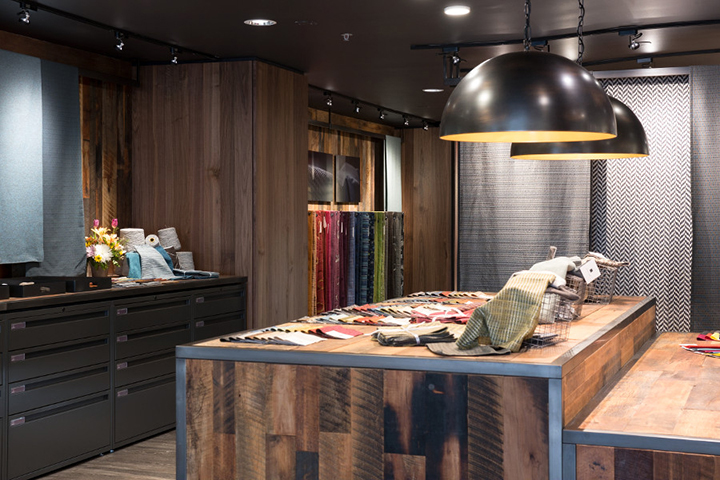NeoCon 2016: 5 Notable Carpet And Textile Trends
News • July 1, 2016

There is a true science and art to imagining, developing and executing each and every one of the stunning textiles and carpets that adorn nearly every surface in and beyond the Merchandise Mart. We spoke with talented designers, insightful trend experts, and incredible artisans about how they achieve the right combination of colors, textures and patterns. Here's a look at five notable carpet and textile trends at NeoCon 2016 and a few of the companies that support them:
1. Blurring of Markets
From furniture to textiles to carpet to showroom design, many new visitors to NeoCon may wonder if the show is focused on office, home or hospitality these days. Many partnerships, brands and product launches at NeoCon 2016 suggest the answer is all of the above, and the lines are blurring. Interface was among four product lines to announce partnerships in conjunction with the new West Elm Workspace brand, bringing design that nods to the comfort of home to the office. Through the partnership, the two companies introduced six new carpet tile products - ranging from linear and geometric to textured. Each pattern is offered with three to six color options and made with 100 percent recycled nylon content from reclaimed fishing nets, harvested in part from the company's Net-Works program. Many furniture showrooms placed an increasing emphasis on fabric lines and partnerships. KI's Pallas textiles underwent a complete rebranding, and the most dramatic showroom renovation was spent creating a beautiful, rustic cove for visitors to learn about and experience the
new Pallas brand. Teknion also created a brand new area for show visitors to experience LUUM, their newly rebranded textiles line. These partnerships and focuses showcase the key role textiles will play as the residential feel invades the office environment, and vertical markets continue to blend.
2. Tools for Customization
As new modular systems are launched that allow designers to customize to their heart's content, the specification process can become more complex. Jackie Dettmar, VP Commercial Design and Product Development at Mohawk Group, says, "Designers are pushing back on the manufacturers to help them. As we design systems that allow specifiers to customize our product, we need to make it easier for them to do so." Along with Mohawk Group's NeoCon launches, including Topography, a gold award-winning collection with new tile sizes that allows designers to create unique interior landscapes by harmonizing natural forms with geometric design, comes a new online tool that helps them make it easier for specifiers. Also sharing this custom-design-made-easy concept, Shaw Contract won a Gold award for software for specifications with their Shaw Contract Design Tool. On the fabric side of this trend, Carnegie now is offering up its design team with its new Xorel Artform launch. This new collection of easy-to-install, environmentally-sound acoustical panels now offers nine new embossed and embroidered patterns in more than 50 colorways, in addition to more than 200 colors already in the collection. Debuting at NeoCon is a new, intricate, customizable embroidered feature atop the Xorel that adorns the 2016 launch of modular acoustical panels. While acoustic panels seem to be all the rage this NeoCon, Carnegie's take on this concept certainly was the most eloquently designed system.
3. Printed-on Textiles and Flooring
Although this "printed-on" concept seemed to be everywhere, perhaps the most notable printed product this year was Tandus Centiva's display of digital printing with star designers to create an edgy new luxury vinyl tile (LVT) collection. The manufacturer showcased four compelling designs by talented designers including Glow, Riot, Trans-Materia and Crystal. But along the lines of the trend mentioned above, Tandus Centiva also is allowing designers to create their own designs (with assistance, of course.) This beautiful design inspiration combined with the ability to customize will open exciting new platforms for the built environment. But this idea of printing on other materials certainly was prevalent elsewhere. Camira Zig Zag is a geometric pattern printed on to any one of the 75 colorways of Camira's new Synergy fabric. Buzzispace featured several "printed on" acoustic panel designs in their Buzzifelt, including one that looked like marble from afar.
4. Sustainability & Natural Materials
Sustainability remains an extremely important topic. Universal Fibers, which won a Gold award for its new introduction of Thrive™, is taking new steps to enable carpet manufacturers to make greener products with the introduction of the most sustainable, high-performance carpet fiber in the world. Dr. Fern Kelly, PhD and Director of Design, talks about Camira's commitment to creating green textiles: "We chose to provide a wide choice of sustainable products, including natural fiber and recycled fabrics that don't have to be coated with caustic materials to meet performance metrics." Camira took sustainability one step further this year announcing its support for Just a Drop, an international water aid charity. For every yard of its new Synergy fabric sold, Camira will make a donation to its Wool for Water campaign to help deliver accessible, clean and safe water where it is needed most. Maharam introduces an inaugural collection of leather that features a variety of grains and textures but forgoes the excessive finishing that characterizes much of the leather available today. And of course we cannot leave Interface out of the sustainability conversation. In an exciting announcement at NeoCon 2016, the company announced it will meet its 2020 goals of becoming net zero, which means the company will consume only as much energy as produced.
5. The Handcrafted, Maker Movement
Jackie Dettmar, VP Commercial Design and Product Development at Mohawk Group, says, "We are experiencing a texture revival in this digital world." - which explains a lot of the beautiful, intricate textures we saw multiple places throughout the show. On the furniture side, this took place as artisans (and sometimes machines) created product right before our eyes including a weaving stand in the LUUM showroom. On the textiles and carpet side, this trend took form with many companies launching one-of-a-kind, intentionally "flawed" products with an "already broken-in" in feel. Individuo, a new fabric from Camira that features a tie-dye-like process that gives it a fluid, graduated color appearance that ensures no two areas of fabric are the same, was inspired by the Artisan trend that romanticizes handmade, handcrafted, creative artwork and textiles. Carnegie, in partnership with Erik Bruce launched a collection of handmade, artisanal, and custom window treatments.
While there are too many other trends (and inspiring companies!) to mention here, a few additional favorites also included: using carpet tile as broadloom (meaning it lays like tile, but looks like broadloom) - see award winners: Mohawk Group Moonscapes and Interface World Woven Collection; bold geometric patterns (See Carnegie Collage); and the idea of "Retro-futuristic" patterns (Note: term shamelessly stolen from the inspiring David Oakey, designer and trends expert for interface). These trends are a nod to nostalgic patterns and colors of the past, but with a modern twist. I sincerely hope these manufacturers and design teams are proud of the energy created at the show and look forward to what they will inspire us with in 2017.

